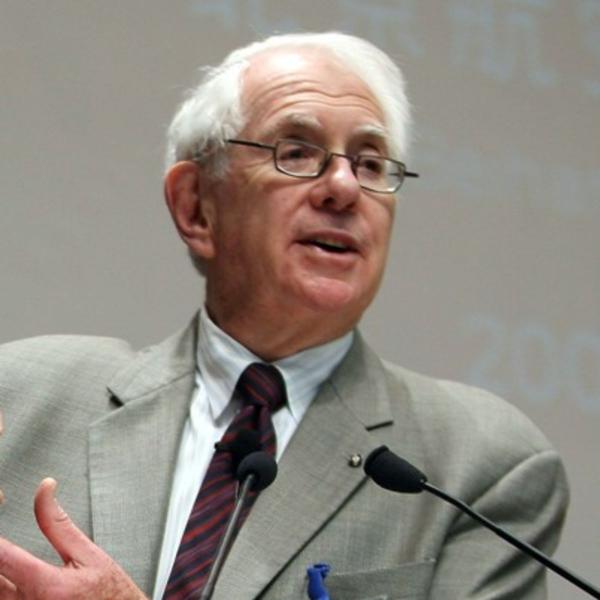Sheldon L. Glashow
Académico Honorario- Profesor Emérito de Física, Harvard University.
- A.B., Cornell University (1954).
- A.M., Harvard University (1955).
- Ph. D., Harvard University (1958).
Sheldon L. Glashow se especializa en la Física Teórica. Su trabajo de investigación abarca aspectos relacionados con la Teoría de las Partículas Elementales y de la Cosmología y la aplicación del concepto de Simetría y de la Teoría de grupos a la Física de Partículas. En 1979 gana el Premio Nobel de Física (junto con Steven Weinberg y Abdus Salam) por su contribución al modelo electro débil, en donde mostró que la fuerza electromagnética y la fuerza nuclear débil, dos de las cuatro fuerzas fundamentales de la naturaleza, son una única interacción unificada, una sola fuerza. Además, predijo la existencia del quark charm, un componente esencial de la materia encontrado en ciertas partículas elementales.
Entre los cargos que ha ocupado están los siguientes:
- NSF Post-Doctoral Fellow (1958-60) Caltech Research Fellow (1960-61)
- Profesor Asistente, Stanford University (1961-62)
- Profesor Asociado, University of California, Berkeley (1962-66)
- Profesor Harvard University (1966-1982)
- Científico Visitante, CERN (1968)
- Profesor Visitante, University of Marseilles (1970)
- Profesor Visitante, MIT (1974)
- Consultor, Brookhaven Laboratory (1964)
- Profesor Visitante, Texas A&M University (1982)
- Científico Senior Afiliado, University of Houston (1982- )
- Científico Visitante Distinguido, Boston University (1984- )
- Profesor Honorario, University of Nanjing (1995- )
- Profesor Higgins de Física, Emérito, Harvard University (2000- )
- Profesor Arthur G.B. Metcalf de Matemática y Ciencias (2000- )
- Profesor Universitario, Boston University (2000- ).
Reconocimientos:
- Premio J. R. Oppenheimer (1976)
- Premio George Ledlie, Harvard (1978)
- Premio Nobel en Física (1979); Premio Castiglione di Sicilia (1983)
- Premio Richtmyer Lecture, Amer. Assn. Physics Teachers (1994)
- Premio Erice Science for Peace (1991)
- Governors Medal, Gifu Prefecture (1998)
- Premio Japan Society for the Promotion of Science (1999)
Además, forma parte de una serie de organizaciones, entre ellas están:
- Academia Nacional de Ciencias de Estados Unidos
- Miembro Honorario, Academia Nacional de Ciencias de Costa Rica
- American Academy of Arts and Sciences
- American Philosophical Society
- Miembro Extranjero, Russian Academy of Sciences
- Miembro Extranjero, Korean Academy of Sciences
- Miembro Extranjero, Accademia Nationale de Lincei
- Miembro, Sigma Xi y Phi Beta Kappa
- Fellow de la AAAS y la American Physical Society
- Miembro Honorario International Raoul Wallenberg Foundation
- Miembro Honorario, Angelo Roncalli Internl Committee
- Presidente, Steering Committee, Campus of Excellence (2007- )
Publicaciones representativas:
- Bova, B. y Glashow, S. L. (1988). Interactions: A journey through the mind of a particle physicist and the matter of this world. Warner Books, New York.
- Cohen, A. G. y Glashow, S. L. (2006). Very Special Relativity. Phys. Rev. Lett. 97:021601; hep-ph/0601236.
- Cohen, A. G. y Glashow, S. L. (2006). A Lorentz-Violating Origin of Neutrino Mass? 7pp. e-Print: hep-ph/0605036.
- Cohen, A. G. y Glashow, S. L. (2011). New Constraints on Neutrino Velocities. arXiv:1109.6562 [hep-ph].
- Glashow, S. L. (1990). The Charm of Physics: Collected Essays of Sheldon Glashow (Masters of Modern Physics). American Institute of Physics.
- Glashow, S. L. (1995). El encanto de la física. Tusquets Editores, Barcelona.
- Glashow, S. L. (1995). From Alchemy to Quarks. Brooks/Cole.
- Glashow, S. L. (2010). Strangeness Violating Dibaryon Decay. arXiv:1007.4140 [hep-ph].
- Glashow, S. L. (2011). Neutrinos and Their Charged Cousins: Are They Secret Sharers? arXiv:1106.3319 [hep-ph].
- Glashow, S. L. (2013). Particle Physics in The United States, A Personal View. arXiv:1305.5482 [hep-ph].











